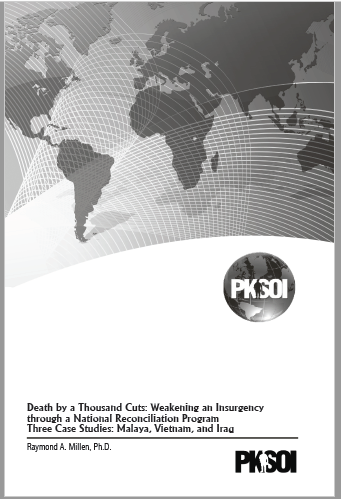Death by a Thousand Cuts

Foreword
Death by a Thousand Cuts explores the application of national reconciliation programs to undermine insurgencies from within and lay the groundwork for stability in the post-conflict period. Dr. Raymond A. Millen presents three case studies—Malaya, South Vietnam, and Iraq—for his examination of national reconciliation programs. Such programs have received little attention after the Vietnam conflict, so this study provides insights of particular interest for US assistance to countries suffering from an insurgency.
The insurgency in Malaya served as a testbed for a national reconciliation program, providing astute observations on the character of the insurgency. In this case, the British and Malayan authorities studied insurgent motivations for surrendering and adapted information operations and the reconciliation program accordingly. In time, they incorporated the reconciliation program into the counterinsurgency strategy, which ultimately proved efficacious. The allies employed the voluntary services of former insurgents in information operations, intelligence collection, and military operations, with great success. Of interest to enduring stability, reconciliation allowed former insurgents to atone for their misdeeds and reintegrate into society.
As most Americans are aware, the Vietnam conflict was an acute threat to South Vietnam’s sovereignty. Following the example and advice of British efforts in Malaya, US and South Vietnamese authorities adopted a national reconciliation program called Chieu Hoi (Open Arms). Also noting Viet Cong disaffection in the ranks, the allies designed information operations and the Chieu Hoi program to encourage surrenders. Moreover, the Republic of Vietnam government established scores of reintegration centers throughout the country, which provided care, education, and vocational skills for ralliers. As in Malaya, the allies employed former Viet Cong in extensive information operations, intelligence exploitation, military operations, and local security. While former Viet Cong successfully reintegrated into society, the long-term effects are unknown, in view of the North Vietnamese invasion and occupation of South Vietnam in 1975.
The insurgency in Iraq is relatively fresh in most American minds. Fortunately, a number of books and the official history of the conflict provide detailed observations of the conflict. From these sources, it appears that US officials initially focused on trying to avert an insurgency, which proved unavailing. Despite the lack of a formal national reconciliation program, Sunni insurgents (and some Shi’a) began making overtures to coalition commanders in 2005, which bore fruit in 2007. Of interest to this study, the use of reintegration programs in detention facilities provides insights for including reconciliation opportunities for incarcerated insurgents.
As Dr. Millen reveals in this study, some telling observations from these case studies are worth noting. First, insurgent cohesion is more friable than assumed, so a reconciliation program must provide a way out for the insurgent’s predicament. Information operations and national reconciliation programs must be designed to inform insurgents of the program, help them surrender safely, assure them of good treatment, and provide opportunities to reenter society as a productive citizen.
Second, host government commitment to the reconciliation program is imperative. Since long-term legitimacy and credibility of reconciliation rests on the host government’s buy-in, allied patrons must devote considerable energy early to that end. Host nation management, resources, and linguistic/cultural acuity make the reconciliation program viable. While a counterinsurgency strategy without a reconciliation program is possible, long-term stability with such a program will not likely endure.
Third, a national reconciliation program requires time, resources, and funding. For counterinsurgency strategists, such an effort may appear inappropriate given the exigencies of the emergency. However, by their nature, insurgencies average ten years, so they are marathons, not sprints. In terms of potential military costs, casualties, and damage, the benefits of a national reconciliation program are worth the investment. The construction of reintegration centers during the insurgency can serve the same purpose for disarmament, demobilization, and reintegration programs in the aftermath of conflict. Again, the value of the investment provides a variety of dividends.
Death by a Thousand Cuts provides a roadmap for assistance to countries embroiled in prolonged insurgencies. The Malayan and South Vietnam case studies provide practical details for the establishment and implementation of a national reconciliation program. The Iraqi case study adds to this knowledge with the use of reconciliation programs as part of detention operations. The defense community would find this PKSOI study profitable for extending global stability.
Scot N. Storey Colonel, Civil Affairs Director, Peacekeeping and Stability Operations Institute 29 April 2020
To read more or to download this document please click on the link or button below.

